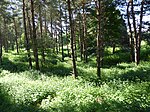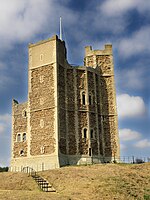Coralline Crag Formation

The Coralline Crag Formation is a geological formation in England. It is a series of marine deposits found near the North Sea coast of Suffolk and characterised by bryozoan and mollusc debris. The deposit, whose onshore occurrence is mainly restricted to the area around Aldeburgh and Orford, is a series of bioclastic calcarenites and silty sands with shell debris, deposited during a short-lived warm period at the start of the Pliocene Epoch of the Neogene Period. Small areas of the rock formation are found in locations such as Boyton and Tattingstone to the south of Orford as well as offshore at Sizewell.Crag is a local word for a shelly sand. Coralline Crag has sometimes been used historically in the Suffolk coast area for building and a number of quarries exist. The tower of St Peter's Church in Chillesford is one of only two built using the rock.
Excerpt from the Wikipedia article Coralline Crag Formation (License: CC BY-SA 3.0, Authors, Images).Coralline Crag Formation
School Road, East Suffolk
Geographical coordinates (GPS) Address Nearby Places Show on map
Geographical coordinates (GPS)
| Latitude | Longitude |
|---|---|
| N 52.12 ° | E 1.53 ° |
Address
School Road
School Road
IP12 2BE East Suffolk
England, United Kingdom
Open on Google Maps











